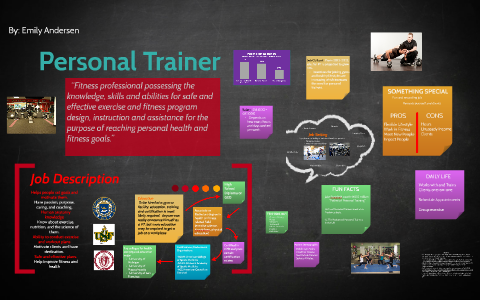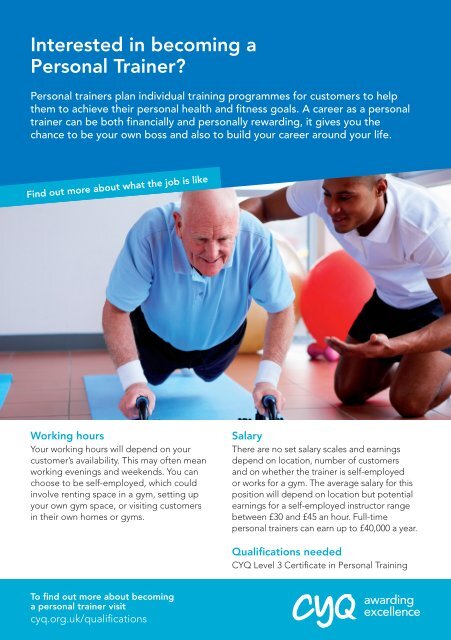
There are many types and styles of personal trainer jobs. You might be wondering how to get started. You'll find information on the working environment, educational requirements and the salary range in this article. You can also learn about the working hours and salary range. For more information, continue reading! You may be interested in a job as a trainer at a gym. Continue reading to find out more about the job description, and how you can get started.
Work environment
Personal training is a different profession than most. Although most personal trainers work from home, the work is very physically demanding. Personal trainers must be able to lift fifty lbs and bend and reach. Flexibility and the ability to work in different environments are essential for this job. Personal trainers are always on the go, so they must be able to travel and work out without feeling tired.
Personal trainers can choose to work in a quiet office or noisy gym. While the former is more comfortable for many people, it is important to keep in mind the client's personality. The stability and predictability of working in a gym might be a plus. However, personal trainers should consider their clients' lifestyles when choosing a work environment. The right work environment for them will depend on what they prefer.

Education Required
To ensure you provide the best possible service to your clients, a certification from a national organization is a great way to get certified. You can get certifications from a number of organizations, such as NASM, ACE and Fitness Mentors. You will be able to begin your career as a personal coach by obtaining a certification. You should be aware that certifications are not free and can be costly. This certification will enable you to give the best care to your clients and to help them be their healthiest. The certification you have will be respected more than a non-certified trainer.
To become a personal trainer, you should be at least 18 years old, and have at least a high school diploma or GED. The GED requirements can be completed with little difficulty. While you don't have to have a college diploma to become a personal training professional, you should be physically fit for this job. The certification allows you to focus on your specific area of fitness, or specialize in other types of fitness.
Salary range
There are many salary options for personal trainers depending on their experience and where they live. Trainers working in big cities might charge $100-150 per session. However, those working in smaller towns and rural areas could earn as low $40 per hour. A personal trainer's salary will increase the more experience they have. On average, trainers earn between PS20,000 and PS30,000 per annum. A personal coach with at least five year's experience should be able to expect to make about $35,000 per calendar year.
An independent personal coach can get a higher salary by obtaining a degree. A degree will allow a trainer's scope to extend beyond working with clients. It can also help them write exercise books and manage large sports teams. A higher degree will increase your value, with 32% earning an advanced degree. You can also get more lucrative job opportunities with a postgrad degree, such a career as a U.S. Army sports trainer.

Hours of work
Personal trainers are usually flexible in their work hours. Some personal trainers work long hours or weekends. Others might work 12-hour days, building client relationships and recruiting new clients. Working from home or at a public fitness facility is not uncommon, as long as you have a flexible schedule. Even cruise ships allow you to work from home! You can read more about this. But first, let's look at the job description and duties of a personal trainer.
You are the boss of your personal trainer. Your clients will not dictate the time that you should train them. The length of your sessions will be up to you. In the beginning, expect to work between twelve and fourteen hours per day. While it's okay to work 12-to-14-hour days while you build your client base and other business relationships, you should not put your health at stake by working 12-14 hours per day.
FAQ
What happens if there isn't enough sleep?
Insufficient sleep can cause your brain to not receive the signals necessary for hormone regulation and other chemicals involved in controlling appetite and metabolism. As a result, you may overeat and gain weight. Overeating can also be caused by a lack of sleep.
Do I lose weight if I exercise?
Yes. Yes. Regular exercise can help you lose weight and burn extra calories. Exercising can increase your metabolism so that you can burn calories even when you're not working out.
What are Cardio Exercises and How Do They Work?
Cardiovascular activities are any exercise that makes your heart work harder than normal. You can do this by running, swimming, biking, rowing and bicycling. These activities burn fat and raise your metabolism. These activities can help you keep fit and strengthen your heart.
What is Nutrition Good for?
Your body can function properly if you get the proper nutrition. The best way to ensure that you receive adequate nutrition is to eat a balanced diet with plenty of fruits and vegetables, lean proteins, whole grains, and healthy fats.
Can I eat during my exercise?
Yes. Yes. You should choose low-calorie snacks, such as watermelon (carrots, celery), apples, bananas and grapes. These foods are high in nutrients, which can improve your performance during training.
Are there any exercises I should not do?
Before starting any new exercise program, you should consult your doctor. There are some people who have medical conditions or injuries that make it difficult to exercise. Some activities may require special equipment, or training. For example, swimming requires a swimsuit and pool access.
Statistics
- An estimated 110,000 deaths per year could be prevented (cdc.gov)
- Globally, 81% of adolescents aged 11-17 years were insufficiently physically active in 2016. (who.int)
- In 2018, the World Health Assembly agreed on a global target to reduce physical inactivity by 15% by 2030 and align with the Sustainable Development Goals. (who.int)
- One study showed that adults who watch more than 4 hours of television daily had an 80% higher risk of death from cardiovascular disease. (heart.org)
External Links
How To
How To Burn Belly Fats Faster
When trying to lose weight, belly fat is often viewed as a problem. But if you think about it, Belly Fat is actually a good thing. It is the fat in your stomach that protects your organs. Let's learn how to quickly burn belly fat.
The two main factors that make us store body fat are stress and lack of exercise. Because of its stimulation of the production hormone cortisol, stress can make us feel hungry continuously. Cortisol increases insulin levels in our blood. The excess calories stored as fat are then stored by insulin. The release of adrenaline from our bodies causes increased appetite. Exercise helps to break down these extra calories.
There are many options to reduce belly weight. Depending on your budget, you can try each one. Here are some quick tips to get rid of belly weight.
-
Eat less food. Don't eat three large meals at once. You'll eat fewer calories this way.
-
Get plenty of water. Water flushes out toxins, and keeps your body hydrated. Water before each meal can help you feel fuller longer and reduce your appetite so that you don't overeat.
-
Avoid eating unhealthy snacks. If you're looking for quick fixes, snack foods like chips, cookies, candies, etc. It might sound tempting. Avoid these unhealthy treats. They are full of empty calories, too much sugar, and can be very fattening. Choose healthy alternatives like fruits and vegetables, nuts, seeds, whole grains, and seeds.
-
At least three times per semaine, do strength training. Strength training increases muscle mass, which can help you burn more calories while still resting. It also strengthens bones, muscles, ligaments, tendons, the heart, lungs, and joints.
-
Move regularly and stretch. Stretching is a great way to increase flexibility and mobility. This helps reduce back pain. Walking for 30 minutes is a great way to burn calories.
-
Reduce alcohol intake. Your diet is empty of calories, and alcohol has no nutritional content.
-
Slowly lose weight. First, determine your current weight. Then, add 5% to 10% to your body weight to get your ideal weight. Once you have reached your target weight, begin decreasing your daily calories intake by 500-1 000 calories until you reach your goal.
-
Avoid processed foods. These foods contain high levels of sugar, salt, and preservatives. Even though they can be very convenient, these foods lack sufficient nutrients to support your health.
-
Don't skip breakfast! Eating breakfast improves concentration, memory, and energy level. Protein (like eggs), fiber and complex carbohydrates (like oatmeal) should be included in breakfast.
-
Have regular bowel movements. Constipation or irregularity can lead to gas and bloating. Drink plenty of water to prevent gas and fiber ingestion.